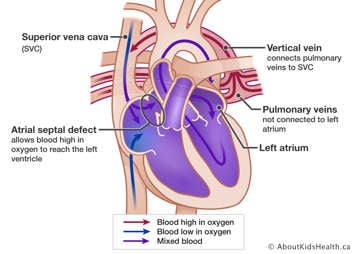In total anomalous pulmonary venous drainage (TAPVD), the vessels that bring oxygen-rich blood back to the heart from the lungs are incorrectly connected to the left atrium. Blood drains to the right atrium through an abnormal vessel.
The two images below compare a normal heart to


An atrial septal defect (ASD) usually accompanies this condition, allowing blood to flow from the right atrium to the left atrium. Without an ASD, the condition is fatal because there is no oxygenated blood returning from the heart to be circulated to the body.
An atrial septal defect (ASD) usually accompanies this condition, allowing blood to flow from the right atrium to the left atrium. Without an ASD, the condition is fatal because there is no oxygenated blood returning from the heart to be circulated to the body.
What are the symptoms of total anomalous pulmonary venous drainage?
Children with total anomalous pulmonary venous return are usually cyanotic, have trouble breathing, and have a heart murmur.
Chest X-rays, echocardiograms, or a cardiac catheterization may be done to diagnose the condition.
How is total anomalous pulmonary venous drainage treated?
Surgery is done very shortly after birth to improve this condition. This involves connecting the pulmonary veins to the left atrium and closing the ASD.
What is the long-term outlook for children with total anomalous pulmonary venous drainage?
With early repair, the outlook is very good for children with this condition.